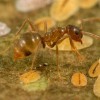Abstract
Nylanderia fulva is part of a group of ants referred to as “crazy ants” due to their quick and erratic movements. It has been reported from 27 counties of Florida and 27 counties of Texas, as well as from Louisiana, Mississippi, Alabama, and Georgia. Huge number of workers in infested areas can make human activities uncomfortable and difficult. They can infest sidewalks, buildings and gardens, and damage phone lines, air conditioning units and computers. They have killed honey bee larvae and used the hives as their nests, and are even displacing red imported fire ants where the two populations overlap in Texas. This 5-page fact sheet was written by Shweta Sharma, John Warner, and Rudolph H. Scheffrahn, and published by the UF Department of Entomology and Nematology, December 2014. (Photo: Lyle Buss, UF/IFAS)
References
Aldana RC, Baena ML, and Chacon de Ulloa L. 1995. Intoduccion de la hormiga loca (Paratrechina fulva) a la reserva natural Laguna de Sonso (Valle del Cauca, Columbia). Bol. Mus. Ent. Univ. Valle. 3: 15-28.
Calibeo D, Oi FM (2011) Integrated pest management (IPM) of the Caribbean crazy ant, Nylanderia (= Paratrechina) pubens (Forel). ENY-2006 (IN889) ed. Gainesville: University of Florida.
Deyrup M. 2003. An updated list of Florida ants (Hymenoptera: Formicidae). Florida Entomologist 86: 43-48. (8 July 2013). https://doi.org/10.1653/0015-4040(2003)086[0043:AULOFA]2.0.CO;2
Deyrup M, Davis L, Cover S. 2000. Exotic ants of Florida. Transactions of the American Entomological Society 126: 293-326.
Fasulo TR, Kern WH, Koehler PG, Short DE. 2005. Pests In and Around the Home. UF/IFAS. SW-126.
Fasulo TR, Koehler PG. 2002. Cockroaches and Pest Ants - Computer-verified Training Tutorials. Bug Tutorials. UF/IFAS. SW-157.
Forel A. 1893. Formicides de l'Antille St. Vincent, récoltées par Mons. H. H. Smith. Transactions of the Entomological Society of London 1893: 333-418.
Giraud T, Pedersen JS, Keller L. 2002. Evolution of supercolonies: the Argentine ants of southern Europe. Proceedings of National Academy of Sciences U.S.A. 99: 6075-6079. https://doi.org/10.1073/pnas.092694199
Gotzek D, Brady SG, Kallal RJ, Lapolla JS. 2012. The importance of using multiple approaches for identifying emerging invasive species: The case of the Rasberry crazy ant in the United States. PLoS ONE 7: e45314. doi:10.1371/journal.pone.0045314. https://doi.org/10.1371/journal.pone.0045314
Harmon K. 2009. Honeybees face new threat in Texas: "Crazy" ants. On-line posting (http://www.scientificamerican.com/blog/post.cfm?id=honeybees-face-new-threat-in-texas-2009-08-07), accessed 5 May 2011.
Klotz JH, Mangold JR, Vail KM, Davis, Jr LR, Patterson RS. 1995. A survey of the urban pest ants (Hymenoptera: Formicidae) of peninsular Florida. Florida Entomologist 78: 109-118. https://doi.org/10.2307/3495674
LaPolla JS, Brady SG, Shattuck SO. 2010. Phylogeny and taxonomy of the Prenolepis genus-group of ants (Hymenoptera: Formicidae). Systematic Entomology 35: 118-131. https://doi.org/10.1111/j.1365-3113.2009.00492.x
LeBrun EG, Jones NT, Gillbert LE. 2014. Chemical warfare among invaders: A detoxification interaction facilitates an ant invasion. Science 1014-1017. https://doi.org/10.1126/science.1245833
MacGown JA, Layton B. 2010. The invasive Rasberry crazy ant, Nylanderia sp. near pubens (Hymenoptera: Formicidae), reported from Mississippi. MidSouth Entomologist 3: 44-47.
Meyers JM. 2008. Identification, distribution and control of an invasive pest ant, Paratrechina sp. (HYMENOPTERA: FORMICIDAE), in Texas. Doctoral dissertation, Texas A&M University.
Say T. 1836. Descriptions of new species of North American Hymenoptera, and observations on some already described. Boston Journal of Natural History 1: 209-305.
Sharma S, Oi DH, Buss EA. 2013a. Honeydew-producing hemipterans in Florida associated with Nylanderia fulva (Hymenoptera: Formicidae), an invasive crazy ant. Florida Entomologist 96: 538-547. https://doi.org/10.1653/024.096.0219
Sharma S, Oi DH, Hodges GS, Gilman EF, Buss EA. 2013b. Associations between hemipteran honeydew producers and Nylanderia fulva (Mayr), with management implications for Florida landscapes. PhD dissertation submitted to University of Florida.
Trager JC. 1984. A revision of the genus Paratrechina (Hymenoptera: Formicidae) of the continental United States. Sociobiology 9: 51-162.
Wetterer JK, Davis O, Williamson JR. (2014). Boom and bust of the tawny Crazy Ant, Nylanderia fulva (Hymenoptera: Formicidae), on St. Croix, US Virgin Islands. Florida Entomologist 97: 1099-1103. https://doi.org/10.1653/024.097.0315
Wetterer JK, Keularts JLW. 2008. Population explosion of the hairy crazy ant, Paratrechina pubens (Hymenoptera: Formicidae), on St. Croix, US Virgin Islands. Florida Entomologist 91: 423-427. https://doi.org/10.1653/0015-4040(2008)91[423:PEOTHC]2.0.CO;2
Zenner-Polania I. 1990. Biological aspects of the "Hormiga Loca", Paratrechina (Nylanderia) fulva (Mayr), in Colombia, pp. 290-297. In: R. K. Vander Meer, K. Jaffe and A. Cedeno [eds.], Applied Myrmecology, A World Perspective. Westview Press, Boulder, Colorado.

